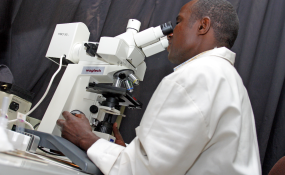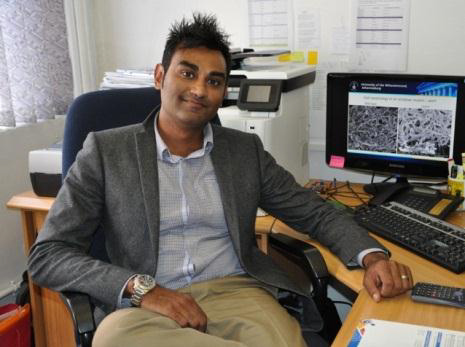Entrevista a: Bavesh Kana
Resumen: Diagnosticar la tuberculosis en personas que tienen VIH ha sido un desafío porque a menudo tienen niveles bajos de bacterias en su sistema. Esto ha sido un serio problema para un país como Sudáfrica donde 454.000 personas están infectadas con tuberculosis cada año, la mitad de las cuales son seropositivas. La editora de Salud y Medicina de Conversation Africa, Candice Bailey, habló con el profesor Bavesh Kana sobre un estudio histórico que proporciona una solución para abordar este problema de diagnóstico.

Diagnosing TB in people who have HIV has been a challenge because they often have low levels of the bacteria in their system. This has been a serious problem for a country like South Africa where 454,000 people are infected with TB each year, half of whom are HIV positive. The Conversation Africa’s Health and Medicine Editor Candice Bailey spoke to Professor Bavesh Kana about a landmark study that provides a solution to tackling this diagnostic problem.
What has the traditional thinking been on TB bacteria and how it grows?
The diagnosis of people infected with the tuberculosis bacteria can show either that they are «active» or «latent» carriers of the disease. People with «active» disease display well known symptoms such as persistent coughing, fever, night sweats and weight loss.
«Latent» infection on the other hand is not associated with any clinical symptoms. People who have latent infection carry a 10% lifetime risk of developing active disease through a process called reactivation. This risk is increased when a person’s immune system is compromised by an HIV-infection or advancing age, for example.
Traditionally, it was thought that people who had active TB harboured bacteria that were easy to replicate through culturing. The thinking was that people with latent infection had dormant bacteria that could not replicate, which are difficult to culture.
To a great extent, this dogma wasn’t underpinned by extensive experimental evidence. This is mainly because its been difficult to model TB disease in small animals or in a laboratory.
Our research shows that these initial views were somewhat simplistic.
What did your research find?
Our research opens a new door to cracking the very difficult problem of diagnosing people who have low levels of TB bacteria, for example people who are HIV positive.
Our findings challenge the conventional thinking because we discovered that patients with active TB in reality harbour mixtures of both replicating and non-replicating organisms. This finding is significant because it will now be possible to diagnose people who previously would have gone undetected. It’s important to emphasise though, that a single TB diagnostic test will unlikely be enough to diagnose all TB disease profiles.
In our study, we explore the presence of non-replicating bacteria that are unable to grow under standard laboratory conditions. We term these as Differentially Culturable Tubercle Bacteria (DCTB).
We expect that detection of differentially culturable bacteria will now make it possible to diagnose people who have low levels of bacteria, for example older people, children and those who are HIV-positive.
How was the research done?
We approached various clinics in Soweto and identified a cohort of TB patients who had drug sensitive TB disease but had not started extensive TB treatment. Many had HIV.
Their sputum samples were subjected to the standard TB tests which includes laboratory culturing. We also applied a growth stimulating technique to the specimen to see if it could be cultured under different circumstances. We were surprised when we uncovered new populations of bacteria that were not detected using standard laboratory culturing.
We compared the results of the different tests with and without growth stimulatory factors to quantify the proportions of replicating and non-replicating bacteria in each sample. We found that using our specialist growth technique, we could more accurately predict the presence of TB disease.
This study has highlighted a previously unknown complexity in the bacterial populations linked to active TB disease. Our research opens new avenues to explore alternate mechanisms for diagnosing and detecting TB bacteria.
More importantly, these findings can be used to develop new ways of understanding how patients respond to treatment. Related to this, is the ability to better assess the efficacy of new TB drugs using the methods employed in our study.
Bavesh Kana receives funding from: The South African Department of Science and Technology The National Research Foundation The South African Medical Research Council The National Health Laboratory Service The Howard Hughes Medical Institute The Bill and Melinda Gates Foundation The Division of Aids (DAIDS) and the National Institutes of Health (USA) The Centre for Aids Prevention Research in South Africa He is affiliated with: The University of the Witwatersrand The National Health Laboratory Service The Centre for Aids Prevention Research in South Africa
Found this article useful? A tax-deductible gift of $30/month helps deliver knowledge-based, ethical journalism.
Fuente: http://allafrica.com/stories/201704010014.html







 Users Today : 101
Users Today : 101 Total Users : 35404123
Total Users : 35404123 Views Today : 118
Views Today : 118 Total views : 3333597
Total views : 3333597